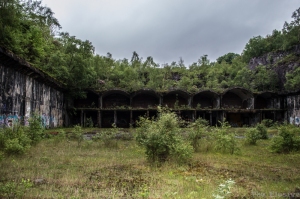This place has been on the list and put off again and again; obviously the tunnel sections have been sealed but the rest was accessible,

Following the apparent success of the design employed at Harpur Hill in Derbyshire, the air ministry decided to use the same technique, converting the eastern pit into an underground depot, but because of the great depth of the quarry the design was adapted to produce a structure with two floors throughout. The lower level and a conventional flat reinforced concrete ceiling which also formed the floor of the upper level which had an arched roof like that at Harpur Hill. Standard and narrow gauge railway lines entered the lower level of the depot through the original quarry access tunnels, while three electric lifts transported bombs to the upper floor. The deep pits to the west of the depot were later used for burning and dumping redundant and dismantled ordnance.
Overhead protection was given by forty feet of broken slate. In response to pressure from the treasury efforts were made to cheapen and accelerate the construction of Llanberis, but unfortunately the cost cutting had disastrous consequences only six months after the depot was opened.On 25th January 1942, two-thirds of the structure collapsed within seconds under the weight of the overlaying backfill, completely engulfing a train of twenty seven wagons which was in the process of unloading. The collapse buried over 14,000 tons of bombs which at the time represented 14% of the total RAF stock. A court of inquiry concluded that faulty design was the principal cause of the failure; cracks were noticed in the structure as the building neared completion but these were attributed to minor defects rather than to a major and fatal miscalculation.
The depot remained in use after the war but all functional stock was removed by March 1955 and the depot closed in July 1956.This wasn’t, however, the end of the story. After the war there was long term activity at Llanberis, in the form of a small RAF detachment of bomb disposal people, patiently clearing dumped weapons. After the war large quantities of incendiaries were dumped into the pits, some water filled, to the rear of the main storage area.From 1969 onwards, the various pits and tunnels were progressively cleared. Members of the EOD Flight burrowed further and deeper into the debris and slate rubble to uncover such items as incendiary bombs and high explosive bomb detonators. The latter, together with the numerous bomb fuses, which were uncovered, were in an extremely hazardous condition and required careful handling. With the help of the Royal Engineers, roads were constructed into the more difficult pits.
Royal Navy divers were co-opted to investigate the contents of a large lake in one of the pits as it was suspected that it might contain some explosive items. The divers reported that the bed of the lake was littered with explosive items including a number of large bombs. Subsequently, over 20,000,000 gallons of water and sludge were pumped out. By April 1973 the lake was emptied revealing everyone’s worst fears; it took a further two years to recover and dispose of the explosive items revealed. Fortunately, this pit was one of those to which 38 Engineer Regiment, RE, had constructed a road, otherwise the task would have been impossible.
On completion of the task, 71 Maintenance Unit EOD Flight had moved approximately 85,000 tons of slate and debris, recovered and disposed of 352 tons of explosive items together with 1,420 tons of non-explosive ordnance debris.
[cycloneslider id=”bombstore”]